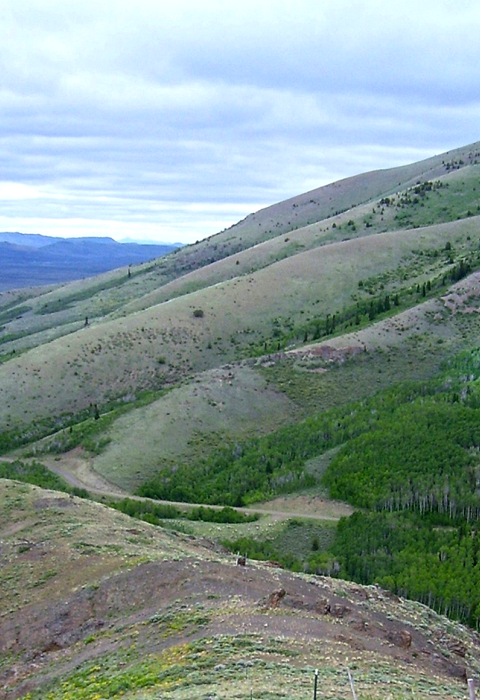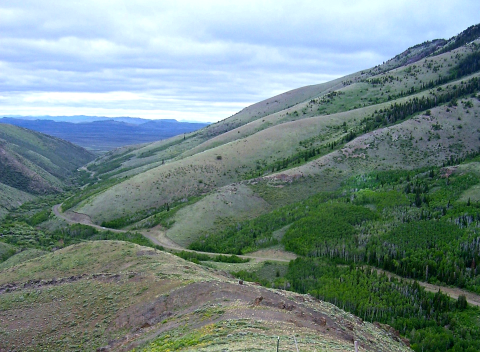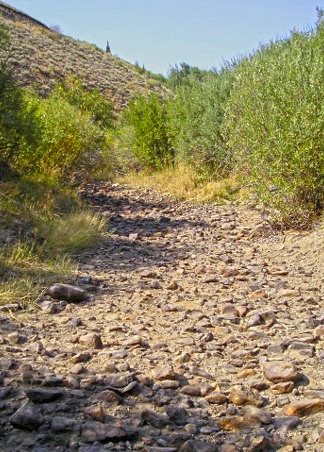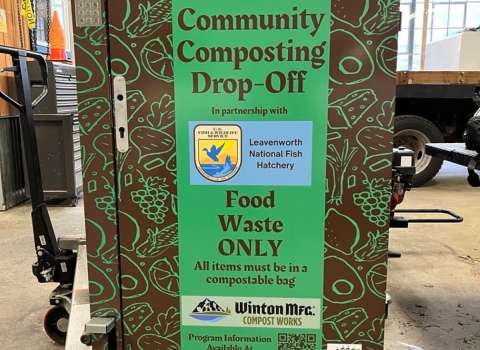Even over a year later, tears well up in his eyes when he talks about it. The “wave of emotion,” as he describes it, is understandable given that the moment was 15 years in the making. “Even last summer when I took my son and his friend out there and told them the story; it still gave me chills to think about it, and just a huge sense of accomplishment.”
In June 2021, Chad Mellison, a fish and wildlife biologist for the U.S. Fish and Wildlife Service in Reno, Nevada, was flyfishing the North Fork of the Humboldt River in northeastern Nevada. Mellison was in the area for field work and had never fished this section of the river before and decided to make a few casts after completing his field work and before heading home.
Little did he know that casting his line in that day would lead to one of the most meaningful moments of his career.
“On my first cast into the pool the fish took my fly! It was totally meant to happen. It was perfect,” said Mellison when describing the moment. After releasing the fish unharmed back in the water, he knew the day wasn’t going to get any better, so he put his fly rod away, ate breakfast and left for home.
Mellison had just caught a Lahontan cutthroat trout in a river where as recently as 2011 the fish did not exist.
“On the way home I thought about all of the people who contributed to making this moment possible and contacted them as soon as I could to share the good news,” he said.
Mellison’s emotional day was only possible because of the tenacity of several dedicated agencies and individuals to return the fish to the river over the course of many, many years.
History of Lahontan cutthroat trout and the North Fork of the Humboldt River
Lahontan cutthroat trout are Nevada’s state fish and the largest inland cutthroat trout in the country. They are also protected under the Endangered Species Act as threatened but can be fished for recreational purposes in accordance with state law.
These top predators once swam in 12 lake systems and more than 7,000 miles of stream in the Lahontan Basin, which extends from the northeast corner of Nevada to California’s central Sierra Nevada mountains. Today Lahontan cutthroat trout occupy just about 10 percent of their historical habitat, which has been altered or lost to water diversions, overgrazing, and competition from non-native fish like rainbow, brook or brown trout.
Lahontan cutthroat trout need the same habitat as any other trout; cold, clean and complex connected waterways to support their entire life cycle.
Faith Machuca, the Service’s Lahontan cutthroat trout recovery ecologist, remembers hearing this from her supervisor her first day on the job. Machuca, who wears her awe of and dedication to saving this fish on her sleeve, will happily talk about Lahontan cutthroat trout biology and the conservation efforts needed to recover them for hours.
“They need cold enough water to be able to persist since they’re cold-water fish,” Machuca. “And not polluted water, and habitat connectivity is really, really important.”
Having enough connected streams and rivers within a system allows the native trout to fully express the variety of their life cycle in a natural way by being able to move around a system.
According to Machuca, a lot of Lahontan cutthroat trout populations are now sequestered to high mountain streams across Northern Nevada and the Eastern Sierra, and they can’t move around the entirety of their historical habitat the way they used to.
“You’ll have resident populations in certain sections of the water year-round,” said Machuca. “But during really good water years, if there’s good, interconnected water, they’ll be able to move to better habitat with changing conditions as the year goes on [and conditions change]. That’s kind of the point of the connected water; when parts of the system dry up, they’re able to move to other parts of the system.”
The North Fork of the Humboldt River and its tributaries once provided this variety of habitat for the Lahontan cutthroat trout there.
The headwaters of the North Fork of the Humboldt River are in the Independence Mountains of northeastern Nevada within the Humboldt-Toiyabe National Forest. From there it flows generally in a southerly direction for more than 95 miles before joining the main branch of the Humboldt River, 15 miles northeast of Elko, Nevada.
In the late 1980s and early ‘90s a gold mine operated in the North Fork’s headwaters. The mine eventually shut down operations, leaving behind several pit lakes. During open-pit surface mining operations, large holes, often hundreds of feet deep and wide, are dug to extract ore body. Groundwater often flows into these pits, which is pumped out during operations. When a mining operation is finished, the pumping stops, and pit lakes form.
Because of the mining operations in the area, state and federal biologists routinely monitored water quality, ground water levels, Lahontan cutthroat population numbers, and even collected data on what insects inhabited the area. In the late ‘90s through the early 2000s, the North Fork population of Lahontan cutthroat trout, which mostly occupied the upper reaches of the river, was estimated to be the biggest stream population in its range, averaging about 4,000 fish, according to a University of Nevada Reno study.
Then something mysterious, yet ultimately detrimental to the thriving population, happened.
In 2006 another mining company was conducting exploratory drilling in the area in search of gold. Following one such exploration, a nearby pit lake left behind by the previous mining operation drained rapidly. After much investigation by the Service, Nevada Department of Wildlife, Nevada Department of Environmental Protection and the mining company, the group surmised that the drilling had connected the local aquifer to another further downstream; essentially acting as a straw between the two.
“Due to the drainage event, the groundwater [level] dropped 226 feet below ground,” said Mellison. “This is significant because it was this groundwater that was pumping out of the springs that were supplying water to the North Fork. The springs supplying water ceased, and the headwaters dried up.”
As the headwaters of the North Fork began to dry up, the Lahontan cutthroat trout there were forced further and further downriver. There they met non-native brook and rainbow trout.
Brook trout outcompete with the Lahontan cutthroat for food and territory, and even eat them. Rainbow trout hybridize with the native cutthroat trout, slowly watering down the genetic integrity of the species.
By 2011, NDOW surveys indicated that the native fish no longer survived in the North Fork of the Humboldt River.
One step at a time
Eventually the exploratory drilling hole was plugged and the aquifer that supplies the North Fork began to fill, and so too did the river. But before Lahontan cutthroat trout could be reintroduced, partners needed to address the ongoing threat of competition and predation by the non-native brook trout.
First, in 2013 the mining company funded and installed a fish barrier on the river within the Humboldt-Toiyabe National Forest to prevent brook trout from traveling further upriver.
A year later, NDOW began the daunting task of removing any remaining brook trout above the fish barrier by treating the river with rotenone, a commonly used, naturally derived compound to remove unwanted fish species to prevent competition for resources with Lahontan cutthroat trout.
“The system is so large and complex, mechanical removal (removing fish by hand) is ineffective. I compare it to removing potato bugs by hand in a potato field,” said Jacob Stoller, a NDOW fisheries biologist. “You’re only capturing like 40-50% of the fish in that area and you can’t effectively collapse the [brook trout] population.”
Nearly 80 people from NDOW and partner agencies worked for two years to remove brook trout on 44 miles of water ways including the North Fork main stem, five tributaries, and connected water diversions all fed by multiple spring sources.
Once the removal efforts were complete, NDOW began returning Lahontan cutthroat trout to the North Fork using fish from other populations in the watershed. Between 2015 and 2018 about 400 cutthroat were put into the river above the fish barrier.
While this was going on, a nearby landowner entered into a Safe Harbor Agreement with the Service and NDOW, agreeing to take part in Lahontan cutthroat trout recovery efforts on their land; in this case, removal of non-native trout to eliminate the threat and allow the native cutthroat to return.
A Safe Harbor Agreement is a voluntary agreement between the Service and private landowners who take action to contribute to the recovery of a federally protected species on their land. In exchange for actively taking part in the recovery of a species, the landowner receives formal assurance that the Service will not require additional or different management activities unless the landowner agrees. Funds provided by the National Fish and Wildlife Foundation, administered by Trout Unlimited, supported the development of this particular SHA along with others in the Great Basin.
Stoller attributes the ability to work with the landowner to years of communication between his agency and others with the local community. Without those relationships, the Safe Harbor Agreement might not have been possible.
Just as things were looking up, a wildfire threatened the river, the fish and the years of hard work partners had put in to restore the habitat and recover the fish.
In August 2018 the South Sugarloaf Fire erupted from a lightning strike southwest of Owyhee, Nevada in Elko County and eventually spread east into the North Fork watershed. In all, the fire burned more than 230,000 acres of federal, Tribal and private land.
Yet, it wasn’t a detrimental setback due to work by the U.S. Forest Service to restore and improve habitat.
“You never know with fire; sometimes it can mean [a species] extirpation,” said Mellison. “Due to good watershed management by the Forest Service, the habitat was in really good shape and able to recover quickly from the fire.”
Biologists are hopeful about the future of the North Fork Lahontan cutthroat trout population and are awaiting eDNA results to confirm that brook trout have been eradicated from the river. The team worked with NFWF and TU to fund $80,000 in eDNA testing in the North Fork and elsewhere throughout Lahontan cutthroat trout's range.
A template for recovery
While Mellison’s banner day in June 2021 represents the results of years of hard work by many, Lahontan cutthroat trout recovery partners – a team of federal, state, Tribal and NGO experts and leadership - recognize that more collaborative efforts like this are needed to save Lahontan cutthroat trout across Nevada, California and Oregon.
To operationalize and focus those efforts, the team developed The 2019 Updated Goals and Objectives -or UGOs - for recovery to guide conservation using current scientific information about the species biology, habitat needs and threats.
The UGOs provide a template for recovery, yet they are not prescriptive because habitat conditions, threats and other factors vary across the Lahontan cutthroat trout range.
In 2023 the Service completed a Status Review of Lahontan cutthroat trout which found that the species continues to decline, and habitat continues to be lost across its range. On the upside, the review also revealed that several populations could be improved in the near term through low-to-moderate level of effort conservation projects, and that knowledge is helping to refine conservation planning for priority populations and habitat.
"We already have the tools needed to recover Lahontan cutthroat trout over the next 5-10 years in existing, priority populations that have a high likelihood of remaining resilient after management actions like sustainable livestock practices or removal of non-native [fish] species are established,” said Machuca.
Bringing Lahontan cutthroat trout back from the brink will take concerted, collaborative efforts, and time and patience agree Machuca and Mellison.
“These things that we do out there don’t always happen overnight. It takes patience, and a good team to navigate the roadblocks,” said Mellison. “You’ve got to have tenacity in this job because you’re going to run into brick walls, and you’ve got to figure out how to get around them.”
Machuca is optimistic that the tenacity of Lahontan cutthroat trout recovery partners will one day restore the native population across its range for all future generations to appreciate as much as she does.
“People are traveling from far away to fish for Lahontan cutthroat trout because they are a really beautiful and unique fish that’s worth traveling here for,” said Machuca. “Chad caught an insanely cool fish in the North Fork of the Humboldt River after this project. And there’s really cool populations elsewhere that you can angle for. I really want the world to see the awesomeness of this fish and that it exists [in rivers and streams] throughout Northern Nevada and parts of California and Oregon."








